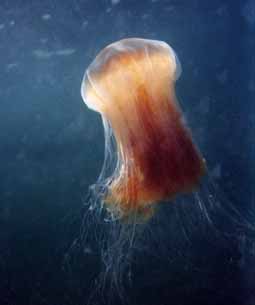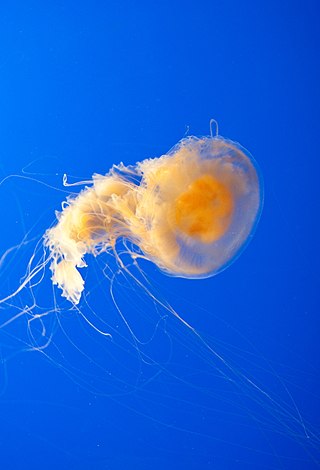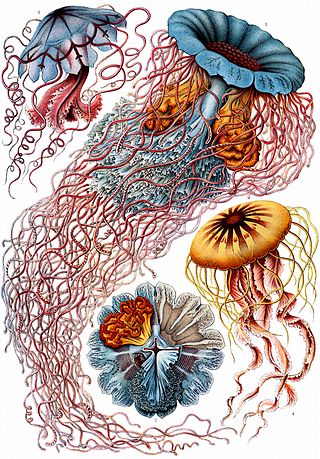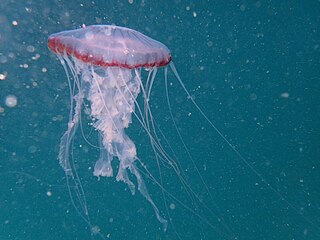
The Scyphozoa are an exclusively marine class of the phylum Cnidaria, referred to as the true jellyfish.

Aurelia aurita is a species of the family Ulmaridae. All species in the genus are very similar, and it is difficult to identify Aurelia medusae without genetic sampling; most of what follows applies equally to all species of the genus.

The Atlantic sea nettle, also called the East Coast sea nettle in the United States, is a species of jellyfish that inhabits the Atlantic coast of the United States. Historically it was confused with several Chrysaora species, resulting in incorrect reports of C. quinquecirrha from other parts of the Atlantic and other oceans. Most recently, C. chesapeakei of estuaries on the Atlantic coast of the United States, as well as the Gulf of Mexico, was only fully recognized as separate from C. quinquecirrha in 2017. It is smaller than the Pacific sea nettle, and has more variable coloration, but is typically pale, pinkish or yellowish, often with radiating more deeply colored stripes on the exumbrella, especially near the margin.

The Pelagiidae are a family of jellyfish. Members of the family Pelagiidae have no ring canal, and the marginal tentacles arise from umbrella margin.

The Cyaneidae are a family of true jellyfish. About 20 species are in this family, including the well-known lion's-mane jellyfish.

Pelagia noctiluca is a jellyfish in the family Pelagiidae and the only currently recognized species in the genus Pelagia. It is typically known in English as the mauve stinger, but other common names are purple-striped jelly, purple stinger, purple people eater, purple jellyfish, luminous jellyfish and night-light jellyfish. In Greek, pelagia means "(she) of the sea", from pelagos "sea, open sea"; in Latin noctiluca is the combining form of nox, "night"", and lux, "light"; thus, Pelagia noctiluca can be described as a marine organism with the ability to glow in the dark (bioluminescence). It is found worldwide in tropical and warm temperate seas, although it is suspected that records outside the North Atlantic region, which includes the Mediterranean and Gulf of Mexico, represent closely related but currently unrecognized species.

Phacellophora camtschatica, commonly known as the fried egg jellyfish or egg-yolk jellyfish, is a very large jellyfish in the family Phacellophoridae. This species can be easily identified by the yellow coloration in the center of its body which closely resembles an egg yolk, hence how it got its common name. Some individuals can have a bell close to 60 cm (2 ft) in diameter, and most individuals have 16 clusters of up to a few dozen tentacles, each up to 6 m (20 ft) long. A smaller jellyfish, Cotylorhiza tuberculata, typically found in warmer water, particularly in the Mediterranean Sea, is also popularly called a fried egg jellyfish. Also, P. camtschatica is sometimes confused with the Lion's mane jellyfish.

Discomedusae is a subclass of jellyfish in the class Scyphozoa. It is the sister taxon of Coronamedusae. Discomedusae contains about 155 named species and there are likely to be many more as yet undescribed. Jellyfish in this subclass are much more likely to have swarming events or form blooms than those in Coronamedusae. Discomedusae consists of two orders, Rhizostomae and Semaeostomeae.

Tiburonia is a genus of jellyfish in the family Ulmaridae. It was reported in 2003, following the discovery of its only species yet identified, Tiburonia granrojo. It was discovered by a crew from MBARI led by George Matsumoto. Pieces of the medusae were collected for morphological analysis, which eventually led to sequencing and taxonomic identification. The discovery of this organism led to not only a new species, but a new subfamily of Ulmaridae, called Tiburoniinae. Its genus was named Tiburonia after the ROV the crew were using, called Tiburon, meaning "shark" in Spanish. Because of this ROVs distinct maneuverability, all angles of the organisms were able to be observed, which is particularly important to the study of gelatinous pelagic invertebrates. Its species name was originally to be called "big ugly", but Kirsten Matsumoto, George Matsumoto's wife, raised objections to this name, and renamed it granrojo, meaning "big red" in Spanish, leading to its English-language name, the Big Red Jellyfish.

Chrysaora colorata (Russell), commonly known as the purple-striped jelly, is a species of jellyfish that exists primarily off the coast of California from Bodega Bay to San Diego. The bell (body) of the jellyfish is up to 70 cm (2.3 ft) in diameter, typically with a radial pattern of stripes. The tentacles vary with the age of the individual, consisting typically of eight marginal long dark arms, and four central frilly oral arms. It is closely studied by scientists due to not much being known about their eating habits. A 15-foot-long specimen has been seen.

Aurelia is a genus of jellyfish that are commonly called moon jellies, which are in the class Scyphozoa. There are currently 25 accepted species and many that are still not formally described.

Chrysaora melanaster, commonly known as the northern sea nettle or brown jellyfish, is a species of jellyfish native to the northern Pacific Ocean and adjacent parts of the Arctic Ocean. It is sometimes referred to as a Pacific sea nettle, but this name is also used for C. fuscescens; the name Japanese sea nettle was also used for this species, but that name now exclusively refers to C. pacifica. Although jellyfish kept in public aquariums sometimes are referred to as C. melanaster, this is the result of the historical naming confusion and these actually are C. pacifica.

Drymonema is a genus of true jellyfish, placed in its own family, the Drymonematidae. There are three species: Drymonema dalmatinum, Drymonema gorgo, and Drymonema larsoni, which are found in the Gulf of Mexico, Atlantic Ocean and Mediterranean Sea.

Drymonema larsoni is a species of jellyfish belonging to the class Scyphozoa. Following a mass sighting in 2000 in the Gulf of Mexico, the species and the rest of its genus were put in their own family, a new subset of the true jellyfish. They were originally thought to be a member of the same family as the lion's mane jellyfish, Cyanea capillata Linnaeus, but they were shown to have morphological and molecular differences. Drymonema larsoni prey heavily upon jellyfish species belonging to the genus Aurelia, and they play an important role in controlling the population of these species.

Sanderia malayensis is a species of jellyfish in the family Pelagiidae, native to the tropical Indo-Pacific. It has a complex life cycle and is thought to be venomous and to have caused injuries to humans.

Chrysaora fulgida, the Benguela compass jelly, is a species of jellyfish in the family Pelagiidae. Found in the southeastern Atlantic Ocean along the western coast of South Africa, its taxonomy has historically caused considerable confusion. Like other sea nettles, its sting is painful, but not generally dangerous unless there is an allergic reaction to the venom.
Chrysaora africana, the purple compass jelly, is a species of jellyfish from the family Pelagiidae. Found in the southeastern Atlantic Ocean from Gabon to the western coast of South Africa, its taxonomy has historically caused considerable confusion. Like other sea nettles, its sting is painful, but not generally dangerous unless there is an allergic reaction to the venom.

Desmonema is a genus of jellyfish under the Cyaneidae family found in colder waters near the Antarctic region and off of the coast of Argentina. They have a bell diameter that can extend over 1 meter and wide tentacles that are grouped together in clusters. They share similar anatomical and physiological structures to the genus Cyanea. Their sophisticated structures like the thick tentacles, sensory systems, and gastrovascular system allow Desmonema to easily capture and extracellularly digest their prey. In recent years, Desmonema were reported to have a commensal relationship with fishes under the Trachurus genus and a parasitic relationship with specimens of the Hyperia genus. The genus name derives from the Ancient Greek desmós (δεσμός), meaning "bond", and nêma (νῆμᾰ), meaning "thread".
Lobonema is a monotypic genus of cnidarians belonging to the family Lobonematidae. The only species is Lobonema smithii.

Aurelia limbata, the brown-banded moon jelly, is a type of moon jelly that occurs in various places throughout the Pacific Ocean.




















